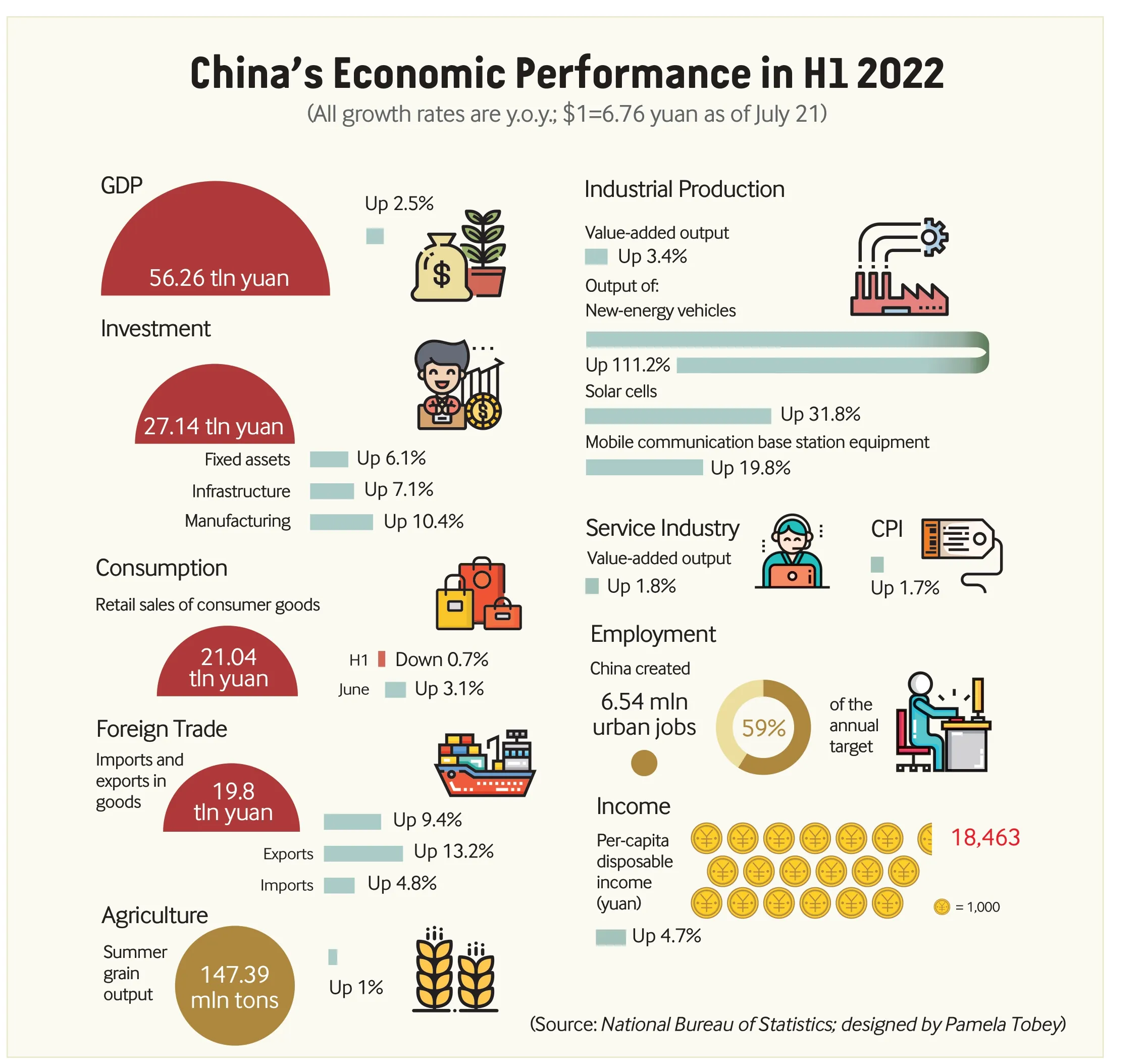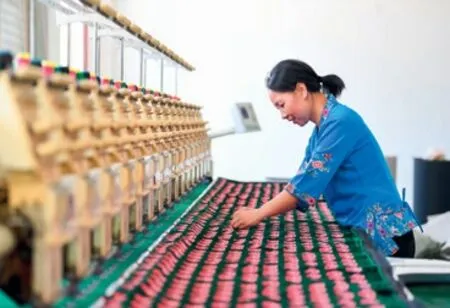SAILING INTO THE WIND
2022-07-28ChinatacklesglobaleconomicchallengesheadonByZhangShasha
China tackles global economic challenges head on By Zhang Shasha
The term butterfly effect famously has its origins in the idea that the flap of a butterfly’s wing in Brazil can set off a chain of events that leads to the formation of a tornado in Texas, the U.S. It is used to describe how small, seemingly inconsequential phenomena have the possibility of creating global impacts.However, when that butterfly is in fact the world’s largest economy, global impacts are unavoidable.
The U.S. consumer price index(CPI), a major gauge of inflation,jumped 9.1 percent year on year in June, a 40-year high, according to the nation’s Bureau of Labor Statistics. In general, higher interest rates are used to bring inflation under control. To curb surging inflation, the U.S. Federal Reserve (Fed) raised its benchmark interest rate by 75 basis points to a range of 1.5-1.75 percent in June—the biggest hike since 1994. Some analysts predict that the Fed may execute a 100-basis-point increase in July. The U.S. dollar is the world’s most widely used currency and makes up nearly 40 percent of the global payments. Interest rate hikes in the U.S., in turn, will force other economies to raise their interest rates to prevent capital outflow.
“The U.S. move to raise interest rates will have a domino effect globally,” Xu Hongcai, Deputy Director of the Economic Policy Commission under the China Association of Policy Science, told, adding that recently the euro and the U.S. dollar have been at parity for the first time in 20 years. “In contrast, the fluctuation of the renminbi remained relatively slight in the first half (H1) of the year, a sign of China’s economic resilience,” he said.
Moreover, China’s CPI went up 1.7 percent year on year in H1, according to the National Bureau of Statistics(NBS). The stable consumer price level is one of the highlights of China’s H1 economic performance.
During the six-month period, the country’s GDP expanded 2.5 percent year on year with a growth of 4.8 percent between January and March and 0.4 percent for the second quarter (Q2).
“The adverse effects of the increasingly complicated international environment and sporadic domestic COVID-19 resurgences imposed greater economic downward pressure in Q2,” Fu Linghui, a spokesperson for the NBS, said at a press conference on July 15. Nevertheless,major economic indicators contracted less in May than in April and returned to positive growth in June, ensuring quarterly expansion, he pointed out.
Impetus and highlights
“The government has attached importance both to COVID-19 control and economic stability, and taken effective measures on both fronts,” Xu said, adding that’s why the country was able to withstand pressures in Q2 and remained on track toward a steady recovery.
On May 31, the State Council unveiled 33 measures covering fiscal and financial support, investment, consumption, food and energy security,industrial and supply chains, and basic livelihood to stabilize the economy.
With their implementation, key economic indicators including the value-added industrial output and purchasing managers’ index began to firm up in May and June and the unemployment rate dropped in those two months.
As one of the troika (investment,consumption and export) driving economic growth, investment played a more significant role in H1. Fixed assets investment increased 6.1 percent with investment in hi-tech manufacturing and hi-tech services registering growth of 23.8 percent and 12.6 percent, respectively.

Containers are loaded from trucks onto a cargo vessel at a port in Tangshan, Hebei Province, on July 16

“The rapid growth of investment in hi-tech sectors speaks volumes about an optimized economic and manufacturing structure and demonstrates sufficient impetus for investment in such sectors,” Xu said.
“The growth rate of investment surpassing that of the GDP indicates that in hard times when the increase of consumption was relatively slow,investment has made up the gap and boosted the economy,” Bai Jingming, a researcher with the Chinese Academy of Fiscal Sciences,told the, a leading Chinese business newspaper.
The resurgences of COVID-19 have been restraining people from socializing and consuming. The retail sales of consumer goods dropped 0.7 percent in H1, but in June,the volume gained 3.1 percent after three consecutive months of decline.
The consumption of new-energy vehicles (NEVs) was a highlight. According to the Ministry of Public Security,the number of newly registered NEVs during the first six months hit 2.21 million, an increase of 100.26 percent year on year, which was a record high. According to the China Passenger Car Association, nationwide sales of new-energy passenger vehicles in the first five months accounted for 59 percent of the global total.
Per-capita disposable income improved 4.7 percent in H1. “The growth was also higher than that of the GDP,indicating the internal momentum of economic growth remains strong,” Bai said.

An embroiderer produces traditional textiles at a workshop in Guizhou Province on July 15
Foreign trade in goods saw an increase of 9.4 percent in H1, with exports up 13.2 percent. In June, the import and export volume grew 14.3 percent with the trade surplus reaching $97.9 billion, establishing a new record.
“The growth of China’s foreign trade in both goods and services has beat expectations,” Zhang Jianping, Deputy Director of the Academic Steering Committee of the Chinese Academy of International Trade and Economic Cooperation, said at a forum hosted by China News Service on July 15.
China’s foreign trade structure has improved with domestic brands accounting for a larger proportion of general trade and their added value continuing to increase, according to Zhang. The growth of China’s trade with other Belt and Road Initiative participating countries has remained higher than that of its total imports and exports; private enterprises have become a vital force in export; and new growth drivers such as crossborder e-commerce have been conducive to stabilizing foreign trade amid the pandemic.
In May, Germany experienced a trade deficit for the first time in 30 years and, against the backdrop of rising global inflation,so have other manufacturing powerhouses such as Japan,Britain and France. “China’s trade surplus expanded,which signifies the country’s competitiveness in manufacturing and the resilience of its supply chain,” Xu said.
However, challenges arise from the global energy supply crunch, food crisis and the recession in some major economies may greatly affect the global market due to shrinking demand, Zhang said. The World Trade Organization has downgraded its forecast for global merchandise trade growth in 2022 from the previous 4.7 percent to 3 percent.
Xu also predicts huge uncertainties for foreign trade in the second half (H2) of the year. “As the Fed and the European Central Bank are likely to further raise interest rates, China’s exports may decline,” he said.
The second half
As the domestic COVID-19 situation improves and the pro-growth policies pay off, the economy is expected to further recover in H2 as the country’s large economic volume, huge market, proactive reforms and strong governance capacity have made it resilient, Fu said.
Xu said May and June already saw key economic indicators rebounding and the momentum will continue in H2. He predicted there would be a robust upturn in the third quarter and the GDP growth will stand at over 5 percent.
However, Zhang Yansheng, chief researcher with the China Center for International Economic Exchanges, said at the forum on July 15 that uncertainties exist both internally and externally.
He said one of the major challenges for economic recovery in H2 lies in stabilizing demand, especially the consumers’ willingness to spend.The retail sales of consumer goods in megacities such as Beijing and Shanghai have not yet recovered from their respective COVID-19 resurgences in H1. The recovery of the service sector takes time, especially for the real estate industry, as well as micro, small and medium-sized enterprises and self-employed individuals, according to Zhang.
Zhang also warned that the economy will be exposed to external risks in H2, including the pressure of imported inflation and the risk of a global economic recession. The global food and energy crises and geopolitical conflicts will add uncertainties to the economic landscape.
Underlining the importance of the resumption of business activities,Zhang said it’s essential to implement existing pro-growth measures and introduce additional policies. He called for increasing infrastructure investment and introducing direct consumption-stimulating measures to motivate the recovery of market entities.
Cheng Shi, chief economist at ICBC International, a subsidiary of the Industrial and Commercial Bank of China, echoed Zhang’s proposals in an interview with.The much anticipated economic rebound in the third quarter will depend on infrastructure investment, while the improvement in the fourth quarter will rely on the recovery of the real estate market, he said. BR
